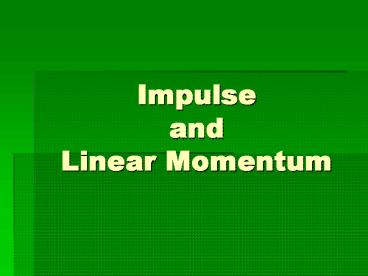Impulse and Linear Momentum - PowerPoint PPT Presentation
1 / 8
Title:
Impulse and Linear Momentum
Description:
The abbreviation for Impulse is I or J but there is no ... An eastward force of 8.0 newtons is applied to a stone for ... Application of the. Impulse ... – PowerPoint PPT presentation
Number of Views:43
Avg rating:3.0/5.0
Title: Impulse and Linear Momentum
1
Impulse and Linear Momentum
2
Definition of Impulse
- Impulse Force x Elapsed Time F(?t)
- The abbreviation for Impulse is I or J but there
is no commonly accepted abbreviation so it is
often abbreviated, F(?t). - The SI Unit for Impulse is Newton?second (N?s).
There is no shortened form for this unit. - Impulse is a vector. (More to follow)
3
Calculating Impulse (1 dimensional situations)
- An eastward force of 8.0 newtons is applied to a
stone for 3.0 seconds. What is the impulse
applied by the force to the stone? - F(?t) (8.0 N)(3.0 s) 24 N?s (eastward)
- A westward force of 12 newtons is applied to a
wagon for 2.0 seconds. What is the impulse
applied by the force to the wagon? - F(?t) (-12 N)(2.0 s) -24 N?s (westward)
- Note that although the magnitudes of the forces
in the two examples are different, the magnitudes
of the impulses are the same. Why is this so?
4
Definition of Linear Momentum
- Linear Momentum mass x velocity mv
- The abbreviation for linear momentum is p, so p
mv. - The SI Unit for linear momentum is kg?m/s.
- N?s (kg?m/s2)?s kg?m/s, so the SI Unit for
linear momentum is the same as the SI Unit for
impulse. - Linear Momentum is a vector just as impulse is.
5
Calculating Linear Momentum (1 dimensional
situations)
- A 1200 kg car travels northward at a speed of 15
m/s. What is the linear momentum of the car? - p mv (1200 kg)(15 m/s) 1.8 x104 kg?m/s
(northward) - A 1800 kg car travels southward at a speed of 10
m/s. What is the linear momentum of the car? - p mv (1800 kg)(-10 m/s) -1.8 x104 kg?m/s
(southward) - Note that although the magnitudes of the
velocities in the two examples are different, the
magnitudes of the linear momenta are the same.
Why is this so?
6
The Impulse-Momentum Theorem
- Derivation
- F ma m(?v/?t)
- THUS F(?t) m(?v) ?p
- SO..
- Impulse change in linear momentum
7
Application of the Impulse-Momentum Theorem
- A 50 kg grocery cart is rolling along the floor
at a speed 4.0 m/s. What force must be applied
to the cart to slow it down to 1.5 m/s in 5.0
seconds? - Solution
- pi mvi (50 kg)(4.0 m/s) 200 kg?m/s
- pf mvf (50 kg)(1.5 m/s) 75 kg?m/s
- ?p pf pi 75 kg?m/s - 200 kg?m/s -125
kg?m/s - F(?t) ?p thus F(5.0 s) -125 kg?m/s
- F -25 kg?m/s2 -25 N
8
Another Example of the Impulse-Momentum Theorem
- A 2.0 kg stone slides eastward along the ice
initially at 15 m/s. A westward force of 10 N
acts on the stone for 4.0 seconds. What is the
velocity of the stone after the force is applied? - Solution
- F(?t) (-10 N)(4.0 s) -40 N?s ?p
- pi mvi (2.0 kg)(15 m/s) 30 kg?m/s
- ?p pf pi thus -40 N?s pf - 30 kg?m/s
- So pf -10 kg?m/s
- vf pf / m (-10 kg?m/s) / 2.0 kg -5.0 m/s
(westward)































